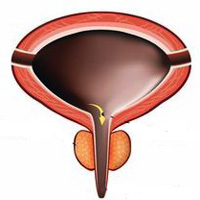Nocturnal polyuria in men performing uroflowmetry for lower urinary tract symptoms

Accepted: March 5, 2021
All claims expressed in this article are solely those of the authors and do not necessarily represent those of their affiliated organizations, or those of the publisher, the editors and the reviewers. Any product that may be evaluated in this article or claim that may be made by its manufacturer is not guaranteed or endorsed by the publisher.
Purpose: To assess the prevalence of nocturnal polyuria (NP) in males performing uroflowmetry (UF) for lower urinary tract symptoms (LUTS), the impact of NP on UF outcomes, and bladder emptying, the association between NP and LUTS.
Materials and methods: Men scheduled for UF were recruited in two Centres. Data collected were medical history, IPSS, UF, post-void residual urine volume (PVR), 3-day frequency-volume charts (FVC). The NP index was used to assess NP with a threshold of ≥ 33%. The relationship between NP and patient’s aging was assessed.
Results: 162 patients were included in the analysis. Mean age was 70.95 ± 8.04 years. The prevalence of NP was 54.9% (89/162). 110 (68%) patients reported nocturia, and among these, NP was documented in 76 (69%). Nocturia was found in 85% (76/89) of the population with NP. Total IPSS score, IPSS items #1, #2 and #7 showed a significant difference in men with NP compared with those without. Maximum flow rate and PVR did not significantly change comparing men with or without NP. Mean voiding volume (VV) of the night-time micturitions was significantly higher in men with NP compared to those without NP (532.1 ± 275.6 ml vs 175 ± 168.7 ml respectively, p < 0001), while mean VV day-time micturitions and mean VV at UF did not change between groups.
Conclusions: NP had a high prevalence in men with LUTS performing UF. Aged males were more commonly affected by NP. Data demonstrated a strong relationship between NP and nocturia and increased urinary frequency while voiding symptoms were poorly related to NP.
Agarwal A, Eryuzlu LN, Cartwright R, et al. What is the most bothersome lower urinary tract symptom? Individual- and population-level perspectives for both men and women. Eur Urol 2014;65:1211-17. DOI: https://doi.org/10.1016/j.eururo.2014.01.019
Fujimura T, Yamada Y, Sugihara T, et al. Nocturia in men is achaotic condition dominated by nocturnal polyuria. Int J Urol 2015;22:496-501. DOI: https://doi.org/10.1111/iju.12710
Weiss JP, Van Kerrebroeck PEV, Klein BM, Nørgaard JP. Excessive nocturnal urine production is a major contributing factor to the etiology of nocturia. J Urol 2011; 186:1358-63. DOI: https://doi.org/10.1016/j.juro.2011.05.083
Chang SC, Lin ATL, Chen KK, Chang LS. Multifactorial nature of male nocturia. Urology 2006; 67:541-4. DOI: https://doi.org/10.1016/j.urology.2005.09.037
Haddad R, Denys P, Arlandis S, et al. Nocturia and nocturnal polyuria in neurological patients: from epidemiology to treatment. A systematic review of the literature. Eur Urol Focus 2020; 6:922-34. DOI: https://doi.org/10.1016/j.euf.2020.02.007
Birder LA, Van Kerrebroeck PEV. Pathophysiological mechanisms of nocturia and nocturnal polyuria: the contribution of cellular function, the urinary bladder urothelium, and circadian rhythm. Urology 2019; 133:14-23. DOI: https://doi.org/10.1016/j.urology.2019.07.020
Cornu JN, Abrams P, Chapple CR, et al. A contemporary assessment of nocturia: Definition, epidemiology, pathophysiology, and management - A systematic review and meta-analysis. Eur Urol. 2012; 62:877-90. DOI: https://doi.org/10.1016/j.eururo.2012.07.004
Van Kerrebroeck P, Abrams P, Chaikin D, et al. The standardisation of terminology in nocturia: Report from the standardisation subcommittee of the international continence society. Neurourol Urodyn. 2002; 21:179-83. DOI: https://doi.org/10.1002/nau.10053
D’Ancona C, Haylen B, Oelke M, et al. The International Continence Society (ICS) report on the terminology for adult male lower urinary tract and pelvic floor symptoms and dysfunction. Neurourol Urodyn. 2019; 38:433-77. DOI: https://doi.org/10.1002/nau.23897
Van Doorn B, Blanker MH, Kok ET, et al. Prevalence, incidence, and resolution of nocturnal polyuria in a longitudinal community-based study in older men: The Krimpen study. Eur Urol. 2013; 63:542-7. DOI: https://doi.org/10.1016/j.eururo.2012.10.004
Gammie A, Drake MJ. The fundamentals of uroflowmetry practice, based on International Continence Society good urodynamic practices recommendations. Neurourol Urodyn. 2018; 37: S44-S49. DOI: https://doi.org/10.1002/nau.23777
Koseoglu H, Aslan G, Ozdemir I, Esen A. Nocturnal polyuria in patients with lower urinary tract symptoms and response to alphablocker therapy. Urology 2006; 67:1188-92. DOI: https://doi.org/10.1016/j.urology.2005.12.018
Swithinbank L V, Vestey S, Abrams P. Nocturnal polyuria in community-dwelling women. BJU Int 2004; 93:523-7. DOI: https://doi.org/10.1111/j.1464-410X.2003.04683.x
Mariappan P, Turner KJ, Sothilingam S, et al. Nocturia, nocturia indices and variables from frequency-volume charts are significantly different in Asian and Caucasian men with lower urinary tract symptoms: A prospective comparison study. BJU Int. 2007; 100:332-6. DOI: https://doi.org/10.1111/j.1464-410X.2007.06979.x
Klingler HC, Heidler H, Madersbacher H, Primus G. Nocturia: An Austrian study on the multifactorial etiology of this symptom. Neurourol Urodyn. 2009; 28:427-31. DOI: https://doi.org/10.1002/nau.20665
Yoong HF, Sundaram MB, Aida Z. Prevalence of nocturnal polyuria in patients with benign prostatic hyperplasia. Med J Malaysia. 2005; 60:294-6.
Thorner DA, Weiss JP. Benign prostatic hyperplasia: symptoms, symptom scores, and outcome measures. Urol Clin North Am. 2009;36:417-29. DOI: https://doi.org/10.1016/j.ucl.2009.07.001
Presicce F, Puccini F, De Nunzio C, et al. Variations of night-time and daytime bladder capacity in patients with nocturia: implication for diagnosis and treatment. J Urol. 2019; 201:962-6. DOI: https://doi.org/10.1097/JU.0000000000000022
PAGEPress has chosen to apply the Creative Commons Attribution NonCommercial 4.0 International License (CC BY-NC 4.0) to all manuscripts to be published.


 https://doi.org/10.4081/aiua.2021.4.445
https://doi.org/10.4081/aiua.2021.4.445



